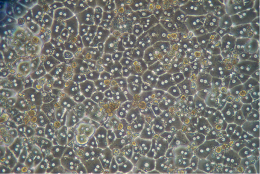One of the biggest challenges as a researcher in life sciences, is to obtain proof of concept the more predictive as possible. To help you to reach your objectives, many innovative tools are being developed and new techniques are emerging. In this post, I’d like to essentially focus on two innovative cell culture devices which mimic in-vivo conditions in in-vitro systems, in fields such as 3D cell culture, Microfluidics and oriented cell culture.
Nanopatterned Cell Cultureware (ANFS) by NanoSurface Biomedical
As described in a previous post on this blog, the unique Anisotropically Nano-Fabricated Substratum (ANFS) technology (NanoSurface Biomedical), promotes the in-vivo like maturation and alignment of in-vitro cell cultures.
By perfectly imitating the in-vivo native cellular microenvironment, this platform helps the cells to attain in vivo-like behaviour such as:
- Cell Maturation
- Cell Proliferation and Migration
- Cell Alignment and Contraction
#1 – ANFS: An accurate tool for oriented cell culture

With its innovative parallel nanoscale topography, the Nanosurface dish will provide many technical advantages, to improve your cellular alignment, structure and function in comparison to other culture platforms. In addition to its perfect fiber orientation, the ANFS dishes are perfectly consistent in the dimension of the nanofibers.
The subcellular dimension of these nanoscale grooves and ridges, has a positive impact on cellular behaviour. With Nanosurface, a single cell can span many grooves, affecting how focal adhesion complexes form, and how the cytoskeleton will rearrange and align to the nanopattern direction, in a way that is not possible on micropatterned surfaces.

#2- ANFS: A well-used and validated tool
This new and unique Anisotropically Nano-Fabricated Substratum (ANFS) technology, has already been used and validated by many researchers, as revealed by the non-exhaustive number of publications available.
Another attractive aspect of the Nanosurface dishes, is that they can promote the in-vivo maturation of many cell types, such as:

- Cardiomyocytes
- Muscle cells
- Human embryonic stem cells
- Cancer cells
- Endothelial cells (and many more)
Also, thanks to their optical properties, they are compatible with a large range of microscopic techniques:
- Live Cell Imaging
- Phase Contrast
- Bright field
- Confocal
In this way, cell culture on NanoSurface dishes becomes more structured, more similar to cells found in-vivo, giving in-vitro results more predictive of what one would expect to see in the body.
3D Cell Culture chip by AIM Biotech

As mentioned above, new and more predictive in-vitro models are needed in life sciences research. In traditional cell culture platforms, the ability to investigate the extracellular microenvironment is restricted, while it appears essential to obtain more physiological and relevant models. Nowadays, 3D models are more physiologically relevant cell culture systems to obtain relevant data with in-vivo observations than classical 2D culture systems.
The 3D Cell Culture chip (AIM Biotech), combines all these requirements and provides a modular microfluidic platform for 3D cell culture, with the capability to monitor the cellular dynamics in response to tuned microenvironment.
#1 – 3D cell culture chip: A large range of applications
Validated by many publications , this 3D cell culture microfluidic platform can be used in a large range of scientific fields:
- Cancer Biology (Spheroid dispersion, New therapeutic approaches…)
- Stem Cell Biology (Differentiation of embryonic stem cells…)
- Vascular Functions (Angiogenesis, Cell Migration…)
- Mechanobiology
- Neurobiology
#2 – 3D cell culture chip: An innovative structure for better 3D cell culture

This microfluidic chip is composed of a central 3D culture compartment, compatible with all kinds of 3D cell culture media, and flanked by 2 media channels (2D culture available). The presence of gas permeable laminate and a “post” between each channel (stabilization of the 3D gel matrix) allows you to increase culture duration in perfect normoxic or hypoxic conditions.
 This structure allows the co-culture of different cell types and complex models of interest with easy tracking and observation of cell movement between the 3 channels.
This structure allows the co-culture of different cell types and complex models of interest with easy tracking and observation of cell movement between the 3 channels.
#3 – 3D cell culture chip: Better control of your in-vivo like model
The multi-channel design not only permits co-culture, but also the possibility for researchers to apply and easily control interstitial flow, pressure and chemical gradiant across the 3D matrix, to work as close as possible to physiological conditions.
#4 – 3D cell culture chip: An optically clear system
Made from polymers with a light transmittance of 92%, this microfluidic AIM Biochip is compatible with many microscopy techniques such as bright-field, fluorescence, phase contrast, confocal and is also available for live cell imaging.
The combination of all these criteria makes the AIM Biotech 3D cell culture Chip, one of the most complete microfluidics systems for your 3D cell culture and physiological studies.
Interested in learning more about these innovative cell culture devices?
Spheroid production from your characterized cell lines
tebu-bio now provides 100% tailored spheroid production as a lab service and according to your requirements:

• From your cell lines (intestine, liver, kidney, pancreas, lung…),
• With a spheroid generation method selected by you (hanging-drop, suspension, inclusion in particular 3D scaffolds, whether synthetic hydrogel or Collagen / Fibrinogen or Matrigel™ or porous bio-materials like Alvetex® scaffold).
• Validation of the quality of spheroids based on your criteria (morphology, viability, proliferation, survival, apoptosis…)
Get in touch with our specialists here to kick-start your project!

Interested in learning more about 3D Cell culture tools like these?
Subscribe to thematic newsletters on your favourite research topics.




